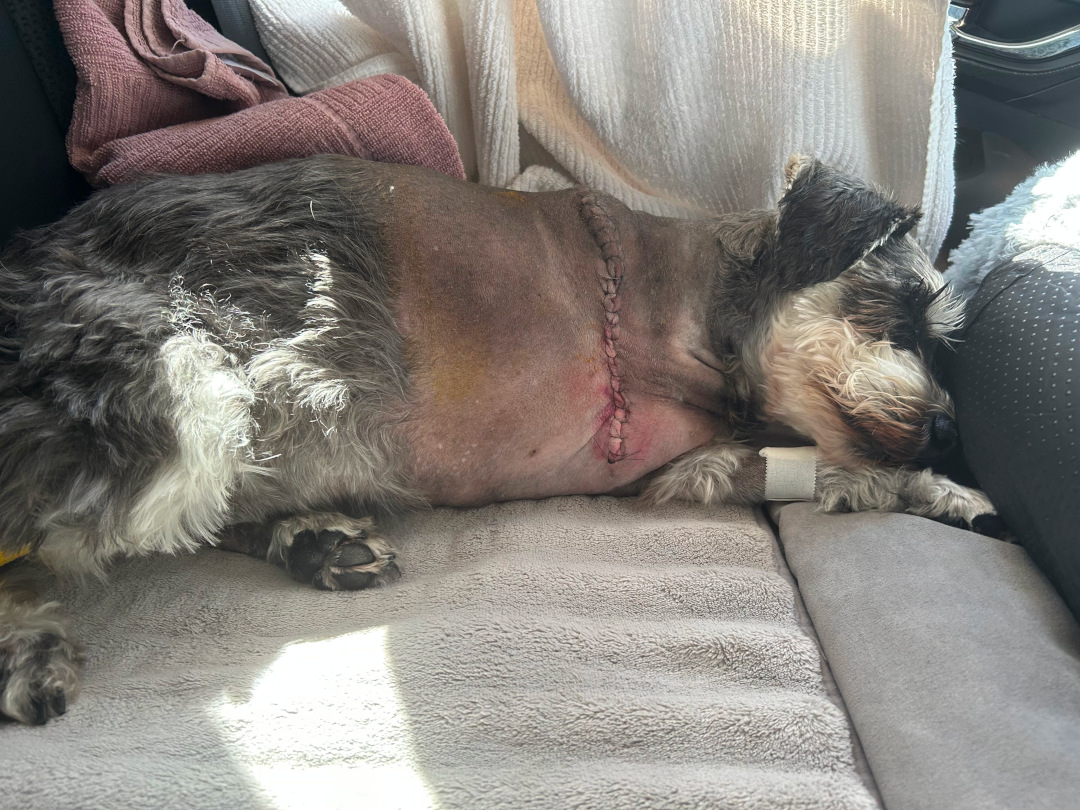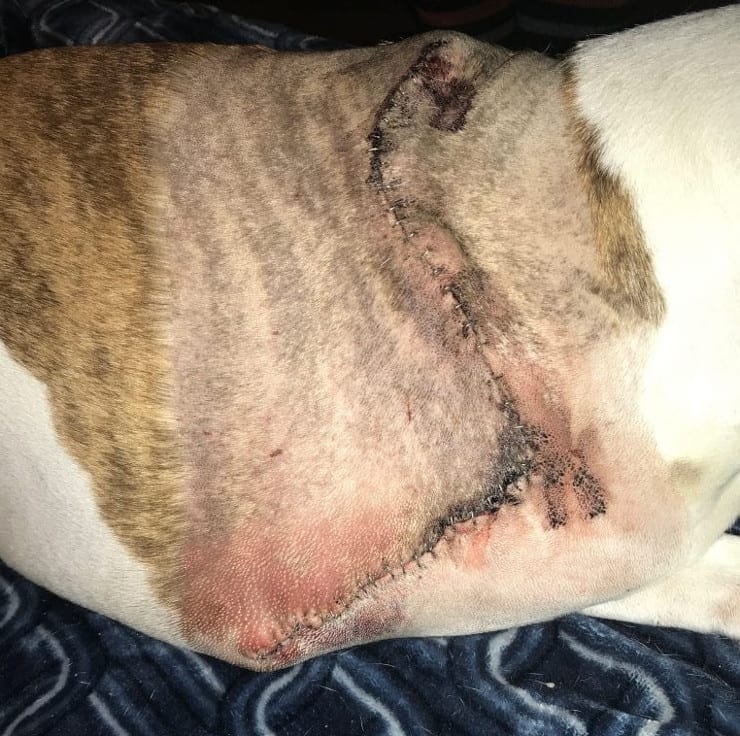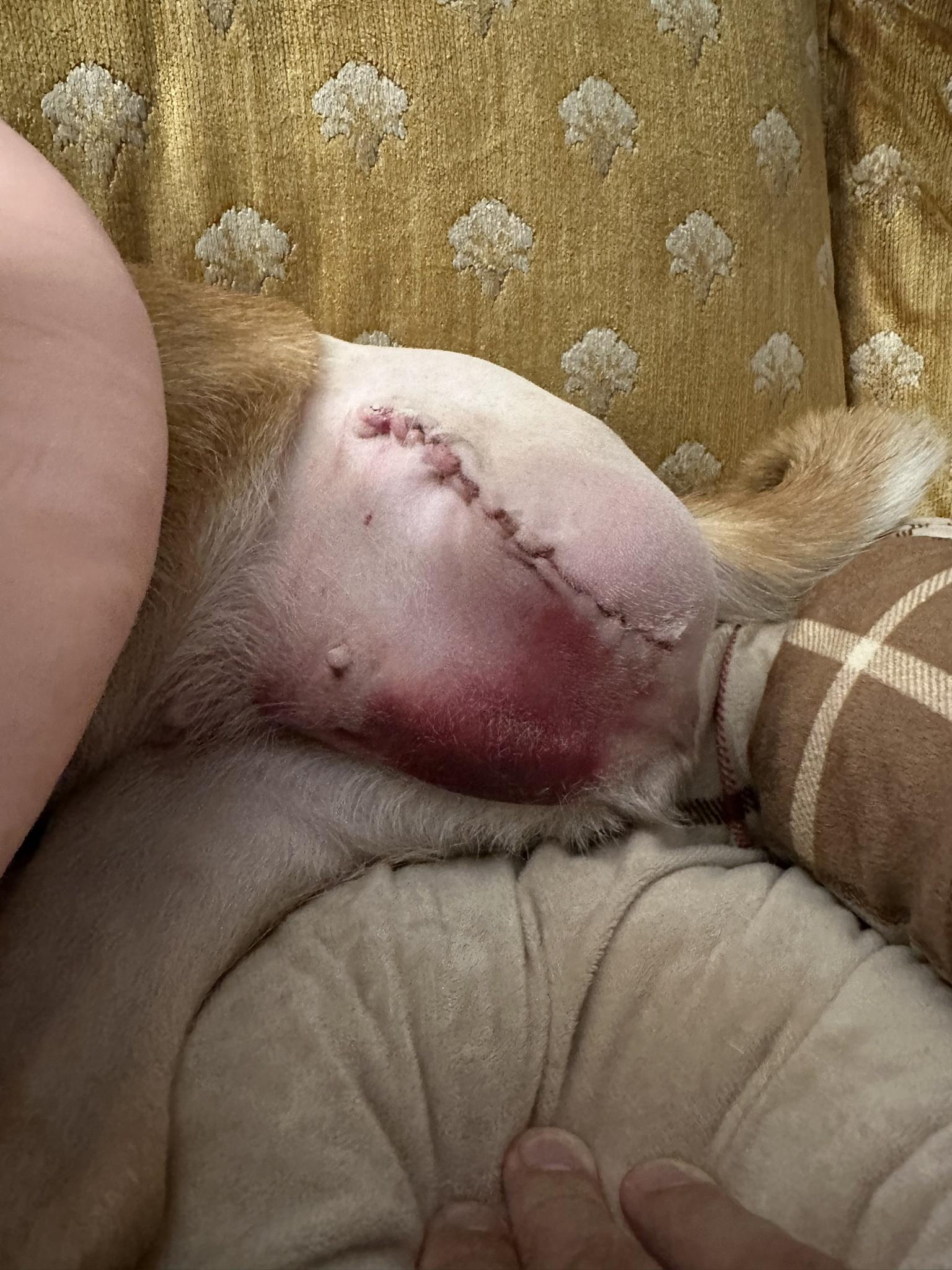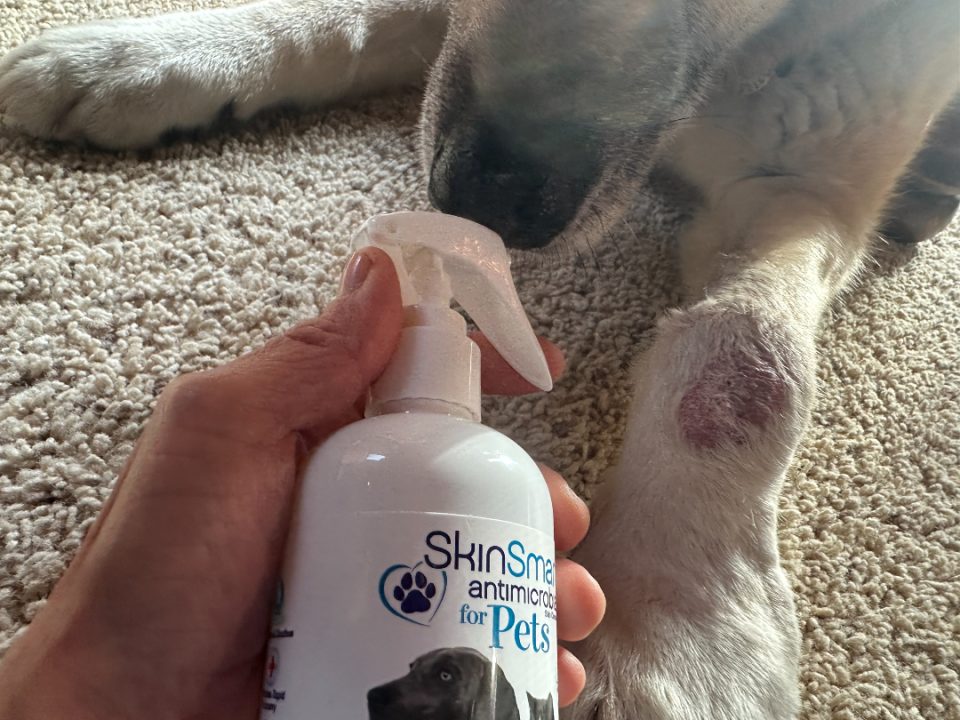Amputation incisions on a dog or cat are scary, but don’t panic. In most cases, you don’t need to do much to it. The area heals within 10-14 days, and a permanent scar forms between 14-21 days. Things do get better! Meanwhile, here’s our best wound care tips for Tripawd dogs and cats that can help put your mind at ease while you wait.
Amputation Wound Care for Tripawd Dogs and Cats isn’t as Scary as You Think
We try to prepare new Tripawd parents for the shock of seeing the incision site. Just visit our Tripawds Photo Gallery, scroll down, and look for the “Surgery and Treatment Pics.”

It’s not pretty. But it’s what has to be done to help our pet regain their quality of life, without pain. Still, most of us have never seen any surgical area that large, so the idea that we have to care for the amputation wound can leave us feeling overwhelming and frightened. Try not to be.
The truth is, there isn’t much we need to do for the incision, other than follow our veterinarian’s instructions. Mainly, to keep an eye on it.
If your Tripawd is wearing a bandage, you can still monitor for infection. Look for fluid drainage and check to make sure the area isn’t warm to the touch, or extremely swollen.
Step 1: Watch for signs of incision infection.

Our article “Tripawd Amputation Incision Infection Symptoms to Know About,” explains the warning signs of an infection incision area, such as:
- Stinky, green or cloudy discharge.
- Excessive seroma fluid (more than 1 drip of fluid per second).
- Loose or missing sutures or staples or a large gap in the incision (more than 1/4 inch) can mean infection is setting in.
- A sudden lump on or around the incision area
Be prepared for the possibility of an infection with first aid items like:
- Sterile gauze pads, large
- Flexible vet wrap
- Vet adhesive tape
- Bandage scissors
- Surgical scrub solution
- Extra clean towels
- Digital thermometer
- Cold and hot pack
- Disposable gloves
Step 2: Watch for signs of a seroma.
An amputation seroma looks scary, but is usually harmless. If you see a puffy area around the incision area, like a water balloon, don’t panic. When part of a body is taken away, all the fluid that was in that body part sometimes takes the path of least resistance instead of reabsorbing into the body. It pools up at the incision site.
You may also notice a clear, watery, pinkish fluid leaking out too. If you suspect a seroma, ask yourself: is the fluid is thick, purple or bloody in color? Is the area or any discharge warm to the touch?
- Make a note of the symptoms, take a couple of photos, and check in with your vet to be sure it’s nothing serious.
Our article about seroma care has tips for using a warm compress to encourage fluid drainage.
Step 3: Keep an eye on the bruising
When a body part is removed, muscles and blood vessels are cut, which causes scary looking amputation bruising. All Tripawd dogs and cats will have incision site bruising. Sometimes it looks worse on certain animals than others (especially if you have a dog or cat with light colored fur).

A cat or dog’s amputation bruise always gets more discolored before it starts getting better. Right after surgery, the skin around the incision area will become angry, dark, and purple in color. Then for about the next five days, the bruises eventually change into shades of green, yellow, and light brown, indicating healing.
As we recommend in our article, “Is My Cat or Dog’s Amputation Bruise Normal?,” there’s not much you need to do about the bruising within the first three days unless your vet instructs you to do otherwise.
You can try gentle heat and ice therapy to minimize discomfort, but wait at least three days after surgery to apply heat and ice therapy.
Also, take daily photos of the incision area.
Progressive photos give you the ability to see progress, or sometimes, not. If you suspect the bruising is not normal, be ready with photos to let your veterinarian know what’s going on.

The Last Step: Don’t Apply Any Topicals to the Incision without Veterinary Approval
If you take one thing from these tips about amputation wound care for Tripawds, please DO NOT clean the wound with anything that your vet hasn’t prescribed.
- Do not use hydrogen peroxide on the incision, it can kill the cells trying to heal causing further complications.
If the wound area gets soiled, use warm water only to clean around the incision and ask your vet what you should to do if further cleaning is necessary.
What to do About Itchy Incision Wounds
Stitches are usually removed 10-12 days after surgery, but that area becomes itchy in the meantime. Many pets go crazy trying to soothe the incision area. Unfortunately the cone of shame is the only surefire way to prevent your dog from damaging the wound.
You may want to ask your veterinarian about SkinSmart Antimicrobial Skin and Wound Care for Pets. We received a sample from the manufacturer, and are happy to know that it can be used during amputation recovery. It’s made with Hypochlorous Acid, a well-researched and proven ingredient that’s been used in the human medical field for decades.

Our fairy vet mother Dr. Pam, took a look at SkinSmart, and gave us the following insight:
It is basically a dilute bleach product and should be safe to use on wounds even post-op amputation sites.
Tripawds’ Volunteer Veterinary Expert Dr. Pam
The main thing for people to realize is that this an OTC product because it is not that strong so if something seems majorly wrong with an incision they should see their vet ASAP. This product is best for superficial abrasions or hot spots rather than deep infections.
And just a note, we are not getting paid to promote the SkinSmart for Pets product. Occasionally one comes along that we feel is important to mention, and this is one of them.
Amputation wound care for Tripawds feels overwhelming at first. But it’s not as scary as you think. The majority of pets do not have any complications, but as always keep your veterinarian in the loop to ensure your dog or cat is on track for a good recovery.

The grey and white poodle mix pup laying on couch at top of this page is an Identical match for mine, who’s having the same right foreleg removed in 2days.
Was so encouraged. Thanks